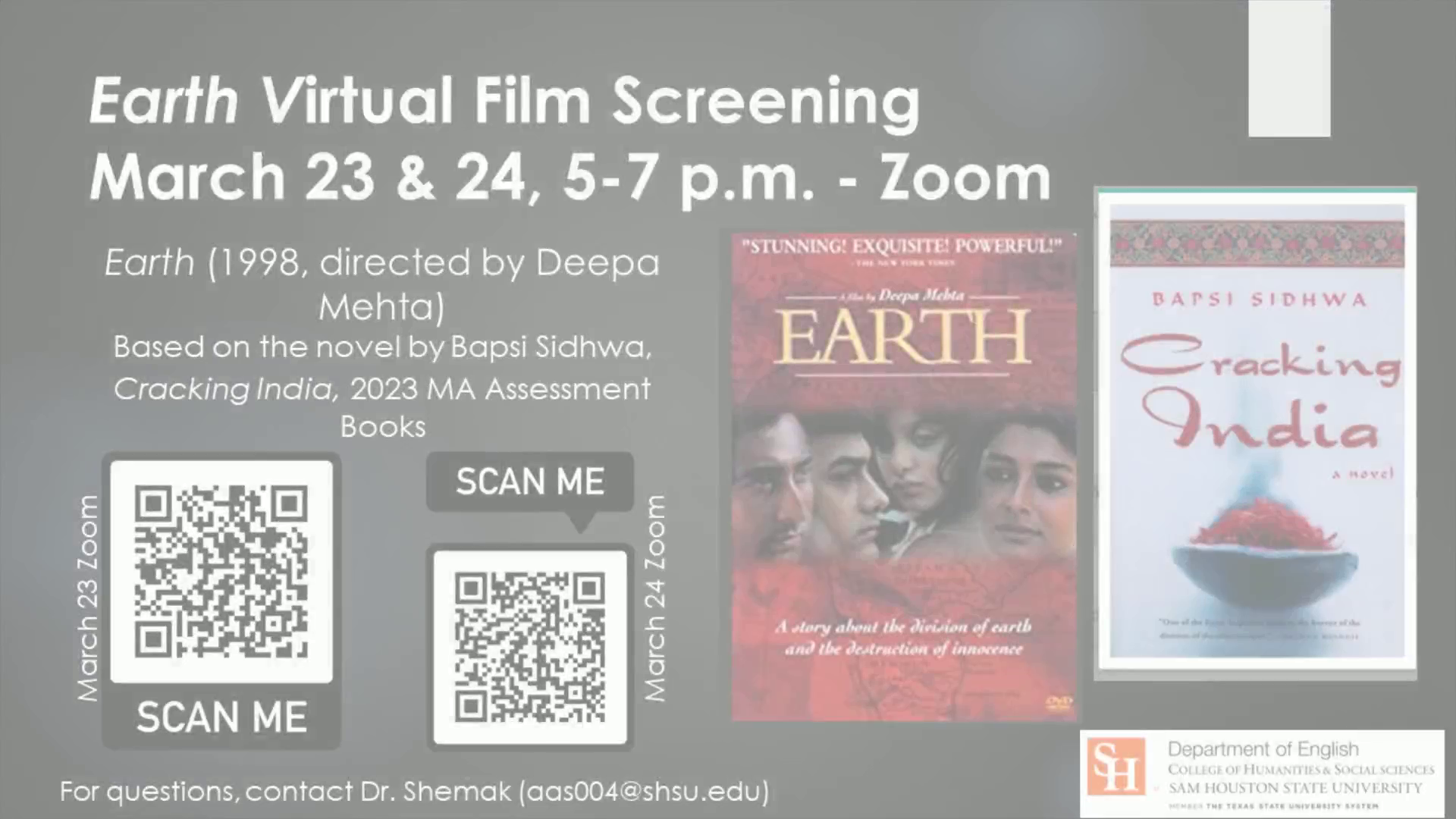Scene 1 (0s)
[Audio] Welcome to this virtual screening of the film Earth. I have a brief introduction to the film that I will show you now before we watch the film. As you know Earth is based on Bapsi Sidhwa's novel Cracking India. Earth is the second film in Deepa Mehta's "elements" trilogy. The first film was "Fire" and was banned in India because the lesbian relationship plotline. The third film in the trilogy is Water about the treatment of widows in India. The connecting theme in the trilogy is the impact of gender and sexuality on the lives of characters..
Scene 2 (40s)
[Audio] August of 2022 marked the 75th anniversary of Indian independence/Partition (India became an independent nation when the British colonizers stopped governing and left India. Many scholars argue that the decision to "carve up" India was too hastily arranged by the British colonizers, which added to the chaotic events of Partition. An estimated 1,000,000 refugees died during the Parition,.
Scene 3 (1m 7s)
[Audio] Partition Carved up the Indian subcontinent, making India for Hindus, Pakistan for Muslims Millions of people were forced to leave their ancestral homes to conform to these new national arrangements (i.e., Hindus in what is now Pakistan migrated to India and vice-versa Later the nation of Bangladesh (formerly East Pakistan) after a war..
Scene 4 (1m 34s)
[Audio] Here is a map showing India during British colonial rule.
Scene 5 (1m 40s)
[Audio] This map shows how Partition carved up the Indian subcontinent, with the arrow pointing to Muslim and Hindu refugee movements..
Scene 6 (1m 50s)
[Audio] Here is another map that shows the post-1947 geo-political divisions.
Scene 7 (1m 57s)
[Audio] These are some things to consider when adapting a book to film. I won't go through all of them now but it is important to keep the differences between the genre of the novel versus film in mind..
Scene 8 (2m 28s)
[Audio] Questions to consider: Which scenes were selected from the book for inclusion in the film? The dinner Papoo's wedding Mother, father, Lenny driving through city—mob overtakes them Which scenes are left out of the film? Is Earth a "faithful" adaptation of Cracking India? Should Sidhwa have any say over the film adaptation of her novel? What is the significance of including other languages besides English in the film? What does the inclusion of subtitles do for the film?.
Scene 9 (3m 8s)
[Audio] An example of reading a scene from the film, with attention to the cinematic elements Opening scene: Begins with Lenny's narration Camera circles around Lenny to show that she is sitting at a desk coloring a map of India Lenny gets up from her desk, adjusts her leg brace and walks (with a limp) into the next room to see her mother The home has red drapes and is shown to be a middle-class home (vase of cut flowers, crystal setting on the table); Lenny picks up one of the pieces of china from the table and intentionally drops it, bringing Ayah rushing into the room to scold her and pick up the pieces; Imam Din steps in from outside, Yousaf then comes in, then Mother arrives, Lenny asks her mother, "Can one break a country?" and reveals that Ayah told her this. Mother tells Ayah/Shanta this is "rubbish" (but notice the look on her face and the anxiety of Ayah's rushed voice) Scene ends. Next Scene: Hari cuts flowers in the garden. Scene focuses on the servants—eating in the kitchen. Scene cuts to Ayah and Adi under the table, whispering and pointing to the feet. The camera pans to above the table and dinner talk.. Camera pans around the table from Lenny's mother, to Mr. Singh, to the English man Mr Rodgers, Lenny's father, who is telling a joke, to the entire table of people. Mr Rodgers—tone of voice is condescending; Mr Singh responds to him in Urdu (?) Notice Lenny's face when she sees them attack each other (she smiles).
Scene 10 (4m 56s)
[Audio] Now, let's watch the film!. Now, let’s watch the film!.
